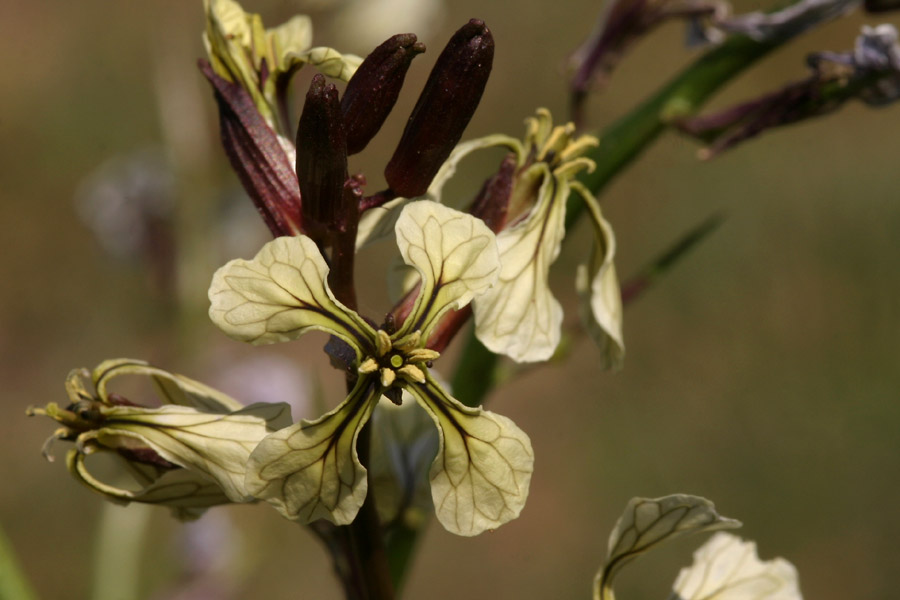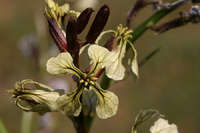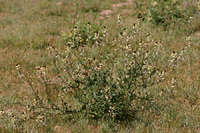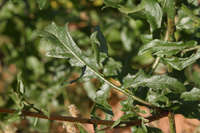Stems usually branched basally, (1-)2-8(-10) dm, glabrous, hirsute, or hispid. Basal leaves (often withered by fruiting); petiole (1-)2-5(-7) cm; blade widely oblanceolate or pinnatisect, (2-)4-15(-20) cm × (10-)20-40(-60) mm, lobes 3-9 on each side, lobe margins entire or dentate. Cauline leaves (distal) subsessile; blade lobed or not, similar to basal. Fruiting pedicels (subappressed to rachis), 2-8(-10) mm. Flowers: sepals (6-)7-10 (-12) × 1.5-2.2 mm, outer pair cucullate or not, glabrous or with subapical tuft of trichomes; petals broadly obovate, (12-)15-20(-26) × (4-)5-7(-9) mm; median filaments (8-)10-13(-15) mm; anthers 2-3 mm. Fruits (1.1-)1.5-3.5(-4) cm × (2.5-)3-5 mm; valves (0.7-) 1-2.5(-3.2) mm; terminal segment 5-veined, (4-)5-10 (-11) mm, as long as or slightly shorter than valves. Seeds pale or grayish brown, 1.6-2.5 mm. 2n = 22.
Flowering Mar-Sep. Roadsides, disturbed areas, waste places, cultivated fields, dry ditches, rocky outcrops, gravelly slopes, sandy plains, open rangelands; 0-1200 m; introduced; Alta., B.C., Man., Ont., Que., Sask.; Ariz., Calif., Colo., Conn., Ill., Iowa, Kans., Md., Mich., Mo., Mont., Nebr., Nev., N.J., N.Mex., N.Y., N.Dak., Oreg., Pa., S.Dak., Tex., Utah, Vt., Wash., W.Va.; Europe; Africa; introduced also in Mexico, Central America, South America, Asia, Atlantic Islands, Australia.
Subspecies sativa, widely naturalized and cultivated, was first introduced as a weed in North America in Flathead County, Montana, in 1898, with additional reports from 1900 to the 1920s as a seed contaminant of alfalfa fields in the United States.
Subspecies vesicaria and pinnatifida (Desfontaines) Emberger & Maire are endemic to Spain and North Africa and have escaped from cultivation in Europe; they seem not to have become adventive in North America (R. C. Rollins 1993). Recent molecular studies by S. I. Warwick and L. D. Black (1993) support the treatment of subsp. vesicaria and its presumed derivative subsp. sativa as a single species; subsp. pinnatifida is maintained as Eruca pinnatifida (Desfontaines) Pomel.
The earliest cultivation of subsp. sativa dates back to the ancient Romans and Greeks. It is currently grown in Europe and North America as a salad plant and in Asia for cooking oil and as food for animals. The oil is also used as an industrial lubricant and for cosmetic and medicinal purposes (I. A. Al-Shehbaz 1985). The seed cake and the entire plant are used as fodder for domestic animals. The oil is high in erucic acid and glucosinolates and is known to cause various skin allergies.
Duration: Annual
Nativity: Non-Native
Lifeform: Forb/Herb
General: Herbaceous annuals, to 1 m tall, stems usually branching basally, herbage glabrous, hirsute, or hispid, plants with pungent, watery sap.
Leaves: Alternate, basal and cauline; basal blades widely oblanceolate or pinnatisect, 2-20 cm long and 10-60 mm wide, lobes 3-9 on each side, lobe margins entire or dentate, uppermost cauline leaves subsessile and similar to basal, basal leaves often withered by fruiting, petioles 1-7 cm long.
Flowers: Cream or yellow (with dark brown or purple veins, the 4 petals forming a cross, petals broadly obovate, 12-26 mm long and 4-9 mm wide, sepals 4, free, 6-12 mm long and 1.5-2 mm wide, lateral pair saccate basally, outer pair cucullate or not, surfaces glabrous or with a subapical tuft of trichomes, stamens 6 with 4 long and 2 short, median filaments 8-15 mm long, anthers yellow, 2-3 mm long, exserted, ovary solitary and superior, generally 2-chambered with a septum connecting 2 parietal placentas, styles solitary, stigmas entire or 2-lobed, flowers borne in elongated racemes at branch tips.
Fruits: Cylindrical siliques dihescent into 2 valves and a septum, 1-4 cm long and 2.5-5 mm wide valves 1-3 mm long, terminal segments sword-like, flattened, seedless, 5-veined, 4-11 mm long, fruiting pedicels stout, erect to ascending or subappressed to rachis,
Ecology: Introduced, found on roadsides, in disturbed areas, waste places, cultivated fields, dry ditches, rocky outcrops, gravelly slopes, sandy plains, and open rangelands, from 0-4,000 ft (0-1219 m); flowering March-September.
Distribution: Widespread across much of the United States, including Arizona, Texas, New Mexico, California, and Nevada. Not present in Colorado or Oklahoma. For more information, see the USDA Plants website or FNA.
Notes: The purple-bracted white flowers with green-veined petals and the stand out among the more common yellow-flowered Arizona mustards. The leaves of this species are thickish, and the deep lobes of the basal blades can make the leaves appear almost pinnate with opposite blades on larger individuals. Jepson has this species as E. vesicaria subsp. sativa. In Kearney and Peebles, look for this species under Brassica eruca.
Ethnobotany: Unknown.
Synonyms: Eruca sativa, others see Tropicos
Editor: LCrumbacher2012
Etymology: Eruca is a classical Latin name used by Pliny, and sativa means "that which is sown," indicating the plant is a cultivated one.
Annual, 2-8 dm; lvs irregularly lyrate, the terminal segment the largest; lower lvs petiolate, the upper sessile; sep caducous, the inner not cucullate; pet white to sordid or ochroleucous, with a few conspicuous purple veins, 1.5-2 cm, the claw surpassing the cal; anthers obtuse; frs erect on short, stout pedicels, the body 12-25 נ3-6 mm, glabrous, the narrowly triangular beak 5-12 mm; 2n=22. Native of Europe, where cult. for salad; intr. or escaped here and there in our range. May, June. Sometimes subordinated to or submerged in E. vesicaria (L.) Cav., a Mediterranean plant with the sep subpersistent and all cucullate, and with acutish anthers.
Gleason, Henry A. & Cronquist, Arthur J. 1991. Manual of vascular plants of northeastern United States and adjacent Canada. lxxv + 910 pp.
©The New York Botanical Garden. All rights reserved. Used by permission.






